











Coordinate points are points extracted from the final registered data sets and are a sub-item of the Processed Data folder. There can be only one set of coordinate points for a project. There are two ways to manipulate Coordinate Points:
| Edit | Launches the Coordinate point Editor |
| Delete All | Deletes all Coordinate Points. The user is prompted via a dialog box to confirm the deletion. |
| Import | Launches the ASCII file import dialog box. |
| Export | Launches the ASCII file export dialog box. |
| Transform | Launches the Transform dialog box to allow the user to define a transformation sequence to apply to the Coordinate points. |
| Field-to-Finish | Draws all Coordinate Points in CAD. The user is prompted to select a Field-to-Finish (.FLD) file. |
| View | Launches the Scene creation dialog box to create a scene for viewing the Coordinate points. |
| Draw | Draws the Coordinate Points in CAD. The user is prompted via a dialog box for the layer to draw the Coordinate Points on. |
Notes: Several commands are available in both the Right-Click menu and in the Coordinate Points editor. The difference between a command in the Right-Click menu and in the Coordinate Points editor is the Right-Click menu commands operate on all Coordinate points. The Coordinate Points editor commands operate on only the selected Coordinate Points. If no Coordinate points are selected the users is asked if they wish to perform the operation on all Coordinate points.
The Coordinate Point Editor is activated when the user right-clicks the Coordinate points Folder and selects Edit. In the coordinate point editor there are several base functions that are shared across all point types, with some extended options added for certain points types.

Along the top is a toolbar with several icons. The icons and their corresponding functions are as follows:

|
Add Point brings up a dialog that allows you to specify the properties of a new point to add. |

|
Edit brings up the point edit dialog which allows you to change properties of the currently selected point. |

|
Copy Points allows you to copy the currently selected points to another point set (such as from the Coordinate points to the target points of a scan). |

|
Delete deletes the currently selected points. |

|
Import Points brings up the ASCII file import dialog. |

|
Export Points brings up the ASCII file export dialog. |

|
Transform allows you to define a transformation sequence to apply to the points. |

|
View brings up the scene creation dialog for viewing the current point set. |

|
Field-to-Finish allows the user to draw the selected Coordinate Points in CAD using Field-to-Finish. The user is prompted to select the Field-to-Finish (.FLD) file to be used. |
| Draw to CAD allows the user to draw the selected Coordinate Points in CAD as CAD points. The user is prompted to select the layer to draw the points on. | |

|
Coordinate System allows you to choose the coordinate system the positions values are in (Global or any current scan positions) |

|
Settings allow you to configure what properties of the points are visible in the spreadsheet control. |

|
Help brings up help documentation. |
Clicking the + button will bring up the add points dialog.

Name is a unique name for the point to be used
to identify it in Point Clouds.
X, Y, and Z are
the x, y, and z coordinates values for the new point to be
added.
Description is a description for the point.
Clicking the import button will bring up the import points dialog, which operates very similarly to the import cloud and import scan dialogs.
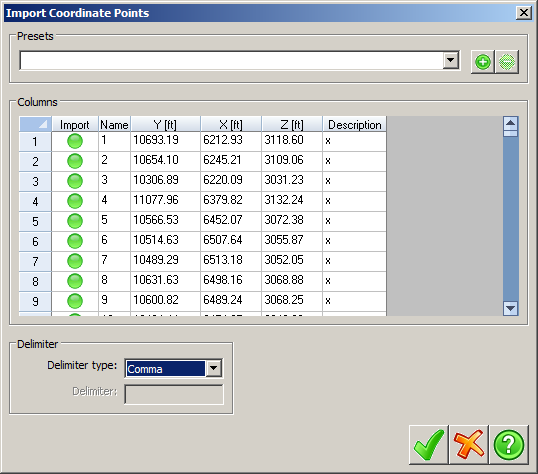
The settings of this import dialog must be configured to match the data ordering of the file being imported. First, ensure that the Delimiter is set to the correct value, if it is there should be multiple columns in the dialog, if it isn't, all of the data should only be in one column. After the delimiter is properly set, the data values for each column must be set. This can be done by clicking the header of each column (which say <Click to Set> by default) to bring up a menu with all the available values that can be set for that column. After settings these values toggle the importing of lines you wish to leave out by clicking the green buttons in the Import column to turn them red. At the top of the dialog is the presets panel, which will allow you to save the current settings if you wish to use them again later. After configuring the dialog to your liking, click the green check to import to continue to the next step. The next dialog displayed will allow you to configure the naming conventions for the points to be imported.
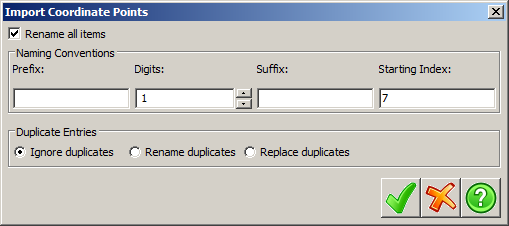
Selecting Rename all items will rename all imported points to the settings specified in the options. The Duplicate Entries panel will specify the action to take when a point being imported has a name that already exists in the set of points being imported to. If the Rename all items toggle is not selected the names listed in the file being imported will be used. If there are no names in the file being imported and Rename all items is not selected, the control points will be named using the settings in Project Settings naming conventions.
Clicking the export button will bring up the export points dialog, which will allow you to export the data to several different file formats.
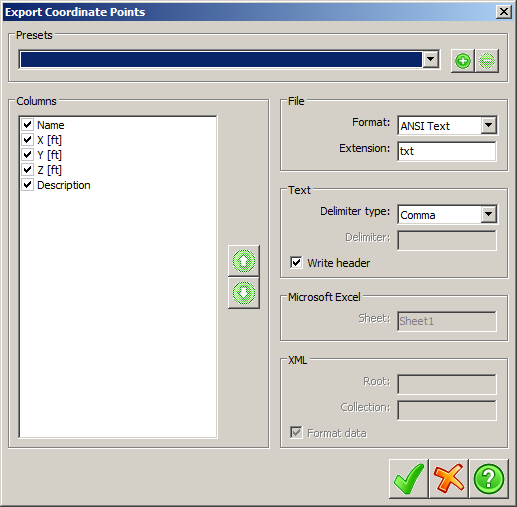
Simply click the check boxes next to the data elements that you
wish to export. To change the order of the data elements in the
file, select the data element you wish to move and click the up or
down arrow to move it.
The File panel determines which file format to
export to and also allows you to specify an extension other than
the default for a given file format.
The Text allows you to specify the
Delimiter to be used as the divider between data
elements in the file and whether to use the Write
header to specify whether to write a header line to the
file detailing the data ordering of the file.
The Transformation allows specifying a sequence of transformations to apply to the currently selected points.
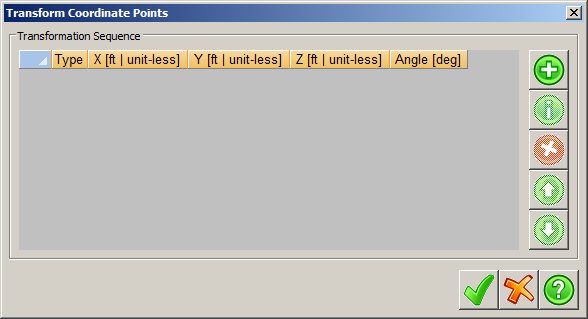
Initially the transformation list is empty. Press the green plus button to add a new transformation, which will bring up a new dialog.

There are three types of transformations, as well as an advanced transformation where the user can specify the transformation matrix to apply.
After the transformation's settings have been configured, pressing the green check mark will add it to the current list of transformations. In the Transformation sequence dialog the following functions apply:

|
Will allow you to edit the currently selected transformation. |

|
Will delete the currently selected transformation. |
 
|
Will change the order of applications of the transformations. Transformations are applied in top-to-bottom order. |
The Settings button will bring up the Coordinate Point Editor settings dialog, which will allow the user to configure which data elements of the current point set are visible, as well as the order that they are displayed in.
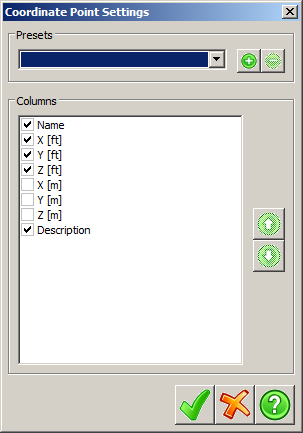
Display of a property can be changed by toggling the check box next to that property, changing the order can be done by first selecting the property to move and then pressing the green up and down arrows to move the selected property up or down. Saving the current settings can be done clicking the plus button in the Presets panel.
Tab Location(s): Project Tab
Panel and Button: Current Project and Coordinate Points
Prerequisite: None